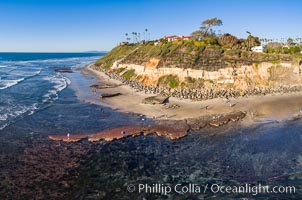
Swamis Reef exposed at extreme low King Tide, Encinitas, aerial panoramic photo.
Location: Swamis, Encinitas, California
Image ID: 37996
Location: Swamis, Encinitas, California
Image ID: 37996
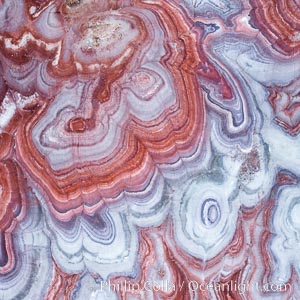
Fantastic colorful sedimentary patterns, Bentonite layers are seen as striations exposed in the Utah Badlands, part of the Brushy Basin shale member of the Morrison Formation. This layer was formed during Jurassic times when mud, silt, fine sand, and volcanic ash were deposited in swamps and lakes. Aerial photograph.
Location: Utah
Image ID: 38020
Location: Utah
Image ID: 38020
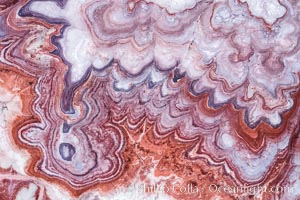
Fantastic colorful sedimentary patterns, Bentonite layers are seen as striations exposed in the Utah Badlands, part of the Brushy Basin shale member of the Morrison Formation. This layer was formed during Jurassic times when mud, silt, fine sand, and volcanic ash were deposited in swamps and lakes. Aerial photograph.
Location: Utah
Image ID: 38021
Location: Utah
Image ID: 38021
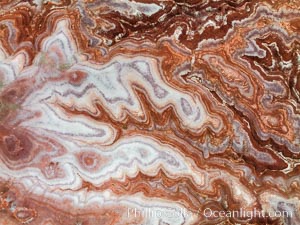
Fantastic colorful sedimentary patterns, Bentonite layers are seen as striations exposed in the Utah Badlands. The Bentonite Hills are composed of the Brushy Basin shale member of the Morrison Formation. This layer was formed during Jurassic times when mud, silt, fine sand, and volcanic ash were deposited in swamps and lakes. Aerial photograph.
Location: Utah
Image ID: 38030
Location: Utah
Image ID: 38030
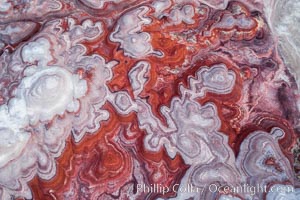
Fantastic colorful sedimentary patterns of Bentonite layers, seen as striations exposed in the Utah Badlands. The Bentonite Hills are composed of the Brushy Basin shale member of the Morrison Formation formed during Jurassic times when mud, silt, fine sand, and volcanic ash were deposited in swamps and lakes into layers, now revealed through erosion. Aerial photograph.
Location: Utah
Image ID: 38047
Location: Utah
Image ID: 38047
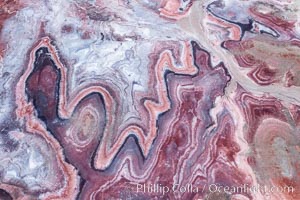
Fantastic colorful sedimentary patterns of Bentonite layers, seen as striations exposed in the Utah Badlands. The Bentonite Hills are composed of the Brushy Basin shale member of the Morrison Formation formed during Jurassic times when mud, silt, fine sand, and volcanic ash were deposited in swamps and lakes into layers, now revealed through erosion. Aerial photograph.
Location: Utah
Image ID: 38053
Location: Utah
Image ID: 38053
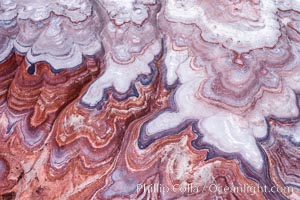
Fantastic colorful sedimentary patterns of Bentonite layers, seen as striations exposed in the Utah Badlands. The Bentonite Hills are composed of the Brushy Basin shale member of the Morrison Formation formed during Jurassic times when mud, silt, fine sand, and volcanic ash were deposited in swamps and lakes into layers, now revealed through erosion. Aerial photograph.
Location: Utah
Image ID: 38056
Location: Utah
Image ID: 38056
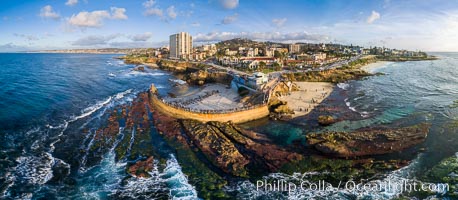
Childrens Pool Reef Exposed at Extreme Low Tide, La Jolla, California. Aerial panoramic photograph.
Location: La Jolla, California
Image ID: 38071
Panorama dimensions: 5543 x 12691
Location: La Jolla, California
Image ID: 38071
Panorama dimensions: 5543 x 12691
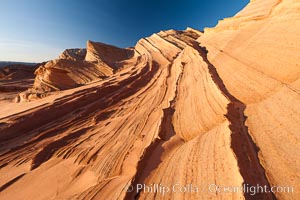
Sandstone "fins", eroded striations that depict how sandstone -- ancient compressed sand -- was laid down in layers over time. Now exposed, the layer erode at different rates, forming delicate "fins" that stretch for long distances.
Location: Navajo Tribal Lands, Page, Arizona
Image ID: 26646
Location: Navajo Tribal Lands, Page, Arizona
Image ID: 26646
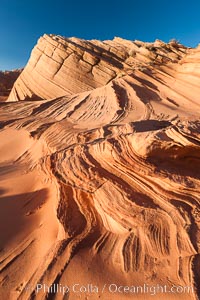
Sandstone "fins", eroded striations that depict how sandstone -- ancient compressed sand -- was laid down in layers over time. Now exposed, the layer erode at different rates, forming delicate "fins" that stretch for long distances.
Location: Navajo Tribal Lands, Page, Arizona
Image ID: 26647
Location: Navajo Tribal Lands, Page, Arizona
Image ID: 26647
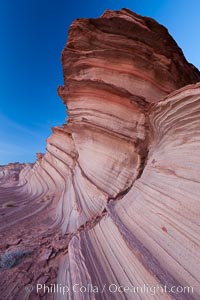
The Great Wall, Navajo Tribal Lands, Arizona. Sandstone "fins", eroded striations that depict how sandstone -- ancient compressed sand -- was laid down in layers over time. Now exposed, the layer erode at different rates, forming delicate "fins" that stretch for long distances.
Location: Navajo Tribal Lands, Page, Arizona
Image ID: 26675
Location: Navajo Tribal Lands, Page, Arizona
Image ID: 26675
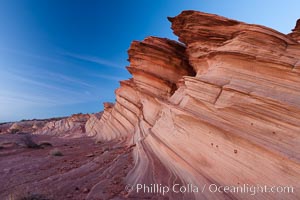
Sandstone "fins", eroded striations that depict how sandstone -- ancient compressed sand -- was laid down in layers over time. Now exposed, the layer erode at different rates, forming delicate "fins" that stretch for long distances.
Location: Navajo Tribal Lands, Page, Arizona
Image ID: 26676
Location: Navajo Tribal Lands, Page, Arizona
Image ID: 26676
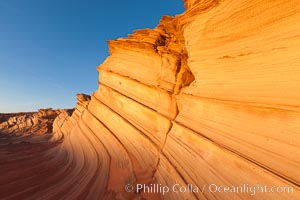
Sandstone "fins", eroded striations that depict how sandstone -- ancient compressed sand -- was laid down in layers over time. Now exposed, the layer erode at different rates, forming delicate "fins" that stretch for long distances.
Location: Navajo Tribal Lands, Page, Arizona
Image ID: 26678
Location: Navajo Tribal Lands, Page, Arizona
Image ID: 26678
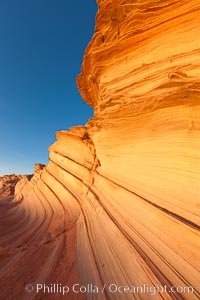
Sandstone "fins", eroded striations that depict how sandstone -- ancient compressed sand -- was laid down in layers over time. Now exposed, the layer erode at different rates, forming delicate "fins" that stretch for long distances.
Location: Navajo Tribal Lands, Page, Arizona
Image ID: 26679
Location: Navajo Tribal Lands, Page, Arizona
Image ID: 26679
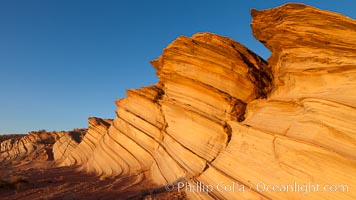
The Great Wall, Navajo Tribal Lands, Arizona. Sandstone "fins", eroded striations that depict how sandstone -- ancient compressed sand -- was laid down in layers over time. Now exposed, the layer erode at different rates, forming delicate "fins" that stretch for long distances.
Location: Navajo Tribal Lands, Page, Arizona
Image ID: 26614
Location: Navajo Tribal Lands, Page, Arizona
Image ID: 26614
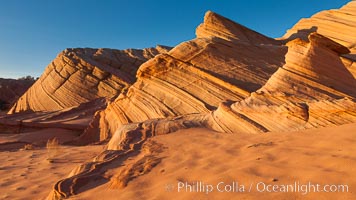
Sandstone "fins", eroded striations that depict how sandstone -- ancient compressed sand -- was laid down in layers over time. Now exposed, the layer erode at different rates, forming delicate "fins" that stretch for long distances.
Location: Navajo Tribal Lands, Page, Arizona
Image ID: 26645
Location: Navajo Tribal Lands, Page, Arizona
Image ID: 26645
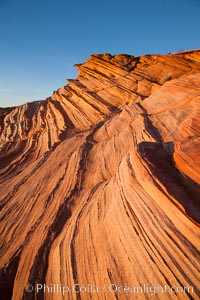
Sandstone "fins", eroded striations that depict how sandstone -- ancient compressed sand -- was laid down in layers over time. Now exposed, the layer erode at different rates, forming delicate "fins" that stretch for long distances.
Location: Navajo Tribal Lands, Page, Arizona
Image ID: 26677
Location: Navajo Tribal Lands, Page, Arizona
Image ID: 26677
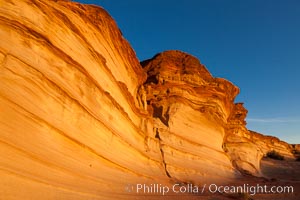
Sandstone "fins", eroded striations that depict how sandstone -- ancient compressed sand -- was laid down in layers over time. Now exposed, the layer erode at different rates, forming delicate "fins" that stretch for long distances.
Location: Navajo Tribal Lands, Page, Arizona
Image ID: 26680
Location: Navajo Tribal Lands, Page, Arizona
Image ID: 26680
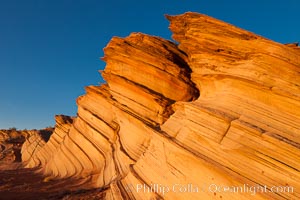
Sandstone "fins", eroded striations that depict how sandstone -- ancient compressed sand -- was laid down in layers over time. Now exposed, the layer erode at different rates, forming delicate "fins" that stretch for long distances.
Location: Navajo Tribal Lands, Page, Arizona
Image ID: 26681
Location: Navajo Tribal Lands, Page, Arizona
Image ID: 26681
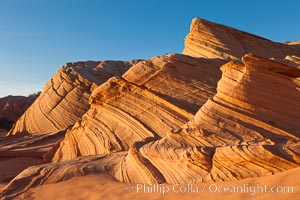
Sandstone "fins", eroded striations that depict how sandstone -- ancient compressed sand -- was laid down in layers over time. Now exposed, the layer erode at different rates, forming delicate "fins" that stretch for long distances.
Location: Navajo Tribal Lands, Page, Arizona
Image ID: 26682
Location: Navajo Tribal Lands, Page, Arizona
Image ID: 26682
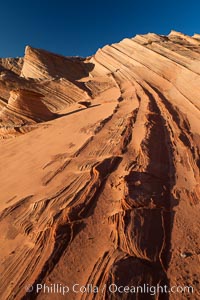
Sandstone "fins", eroded striations that depict how sandstone -- ancient compressed sand -- was laid down in layers over time. Now exposed, the layer erode at different rates, forming delicate "fins" that stretch for long distances.
Location: Navajo Tribal Lands, Page, Arizona
Image ID: 26683
Location: Navajo Tribal Lands, Page, Arizona
Image ID: 26683
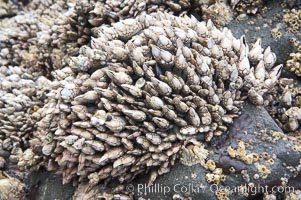
Gooseneck barnacles, exposed at low tide, adhere to a rock. The shell, or capitulum, of the gooseneck barnacle grows to be about two inches long. It is made up of small plates, which enclose its soft body. Inside the shell, the barnacle primarily consists of long segmented legs, intestines and stomach.
Species: Gooseneck barnacle, Pollicipes polymerus
Location: Ruby Beach, Olympic National Park, Washington
Image ID: 13779
Species: Gooseneck barnacle, Pollicipes polymerus
Location: Ruby Beach, Olympic National Park, Washington
Image ID: 13779
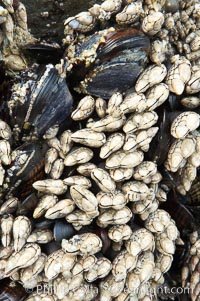
Gooseneck barnacles, exposed at low tide, adhere to a rock. The shell, or capitulum, of the gooseneck barnacle grows to be about two inches long. It is made up of small plates, which enclose its soft body. Inside the shell, the barnacle primarily consists of long segmented legs, intestines and stomach.
Species: Gooseneck barnacle, Pollicipes polymerus
Location: Ruby Beach, Olympic National Park, Washington
Image ID: 13798
Species: Gooseneck barnacle, Pollicipes polymerus
Location: Ruby Beach, Olympic National Park, Washington
Image ID: 13798
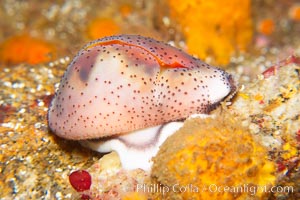
Chestnut cowry, mantle exposed to completely cover the hard exterior shell.
Species: Chestnut cowrie, Date cowrie, Cypraea spadicea
Image ID: 14020
Species: Chestnut cowrie, Date cowrie, Cypraea spadicea
Image ID: 14020
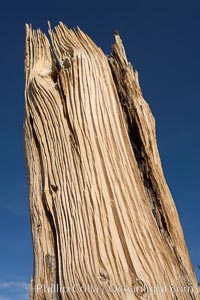
Intense sun, extremely arid conditions, high winds and winter exposure wear away at the exposed bark of a bristlecone pine, leaving striations along its exterior. A small amount of living bark is all that is necessary to sustain a mature bristlecone pine tree into extreme old age. Patriarch Grove, Ancient Bristlecone Pine Forest.
Species: Bristlecone pine, Pinus longaeva
Location: White Mountains, Inyo National Forest, California
Image ID: 17488
Species: Bristlecone pine, Pinus longaeva
Location: White Mountains, Inyo National Forest, California
Image ID: 17488
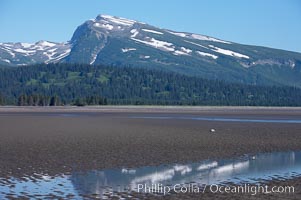
Tide flats exposed at low tide, with Chigmit Range in the background.
Location: Lake Clark National Park, Alaska
Image ID: 19060
Location: Lake Clark National Park, Alaska
Image ID: 19060
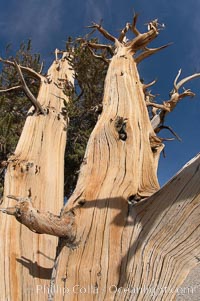
Intense sun, extremely arid conditions, high winds and winter exposure wear away at the exposed bark of a bristlecone pine, leaving striations along its exterior. A small amount of living bark is all that is necessary to sustain a mature bristlecone pine tree into extreme old age. Patriarch Grove, Ancient Bristlecone Pine Forest.
Species: Bristlecone pine, Pinus longaeva
Location: White Mountains, Inyo National Forest, California
Image ID: 17483
Species: Bristlecone pine, Pinus longaeva
Location: White Mountains, Inyo National Forest, California
Image ID: 17483
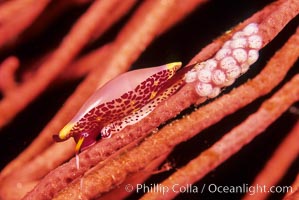
Simnia and egg cluster on gorgonian.
Species: Simnia, Delonovolva aequalis
Location: Anacapa Island, California
Image ID: 07025
Species: Simnia, Delonovolva aequalis
Location: Anacapa Island, California
Image ID: 07025
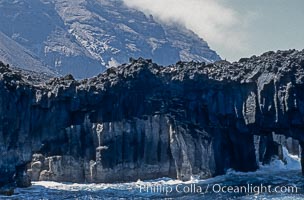
Arcos del Diablo (Devils Arches), a series of enormous volcanic arches that were originally lava tubes. Some of the arches are exposed above water (seen here) while at least one that we discovered is entirely submarine (El Secreto del Vicki). Weather side of Guadalupe Island (Isla Guadalupe).
Location: Guadalupe Island (Isla Guadalupe), Baja California, Mexico
Image ID: 09763
Location: Guadalupe Island (Isla Guadalupe), Baja California, Mexico
Image ID: 09763
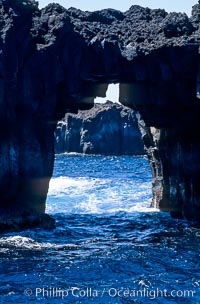
Arcos del Diablo (Devils Arches), a series of enormous volcanic arches that were originally lava tubes. Some of the arches are exposed above water (seen here) while at least one that we discovered is entirely submarine (El Secreto del Vicki). Weather side of Guadalupe Island (Isla Guadalupe).
Location: Guadalupe Island (Isla Guadalupe), Baja California, Mexico
Image ID: 09764
Location: Guadalupe Island (Isla Guadalupe), Baja California, Mexico
Image ID: 09764